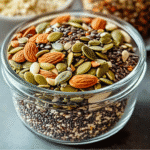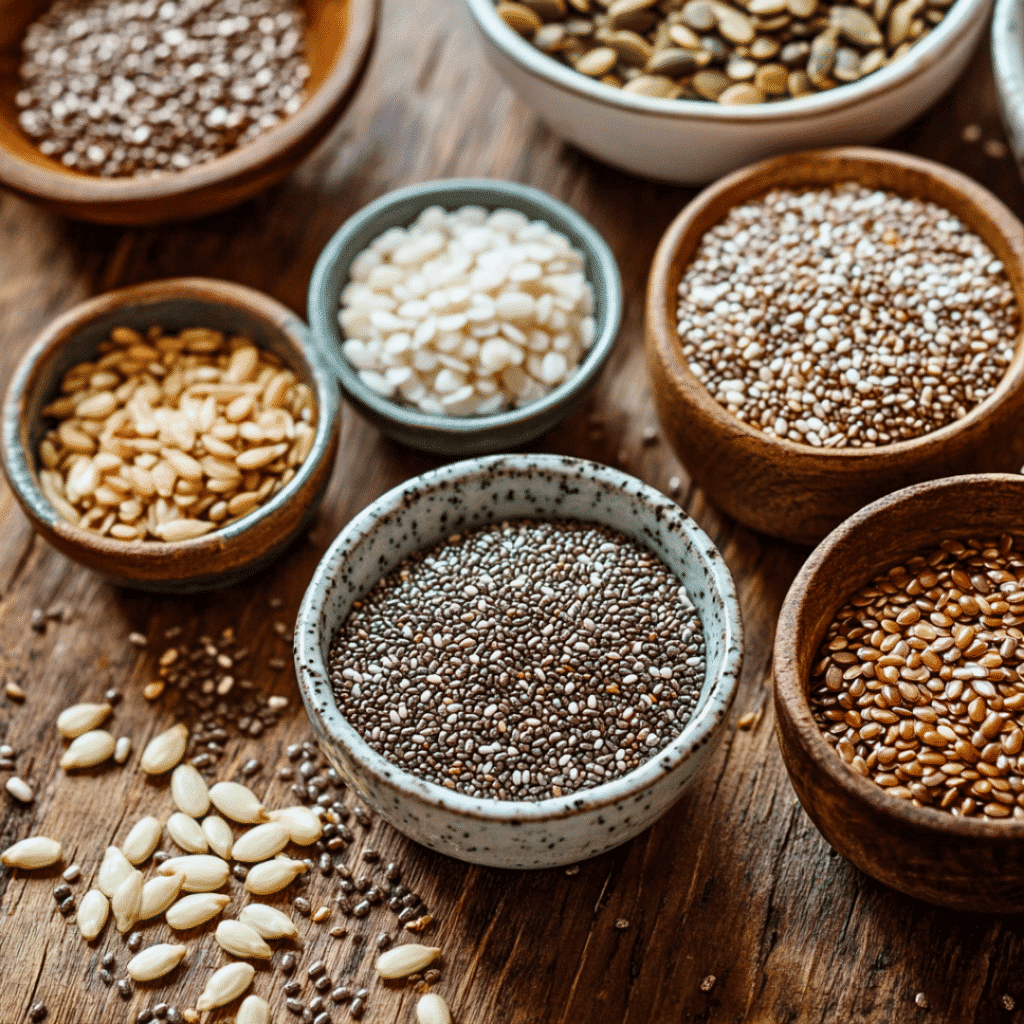Bariatric Seed Recipe for Weight Loss: Easy, Powerful, Real Results
A good bariatric seed recipe isn’t just some ground-up chia and hope. It’s a strategy. Seeds are tiny powerhouses that can completely transform your recovery diet. In this guide, I’ll show you the seed blend I swear by, why it works, how to use it, and how to avoid common pitfalls. Whether you’re weeks out from surgery or years into maintenance, this recipe can bring back flavor, function, and freedom.
For a unique twist that helped accelerate my results, check out my bariatric seed trick recipe—it’s one of the easiest ways to start using bariatric seed blends effectively.
Table of Contents
Table of Contents
Why bariatric seed recipe Became My Secret Weapon
Hey there—I’m Enzo, and if there’s one thing I’ve learned over the years, it’s that a little patience and the right mix of ingredients can work miracles, especially after bariatric surgery. When I went through my own weight loss journey, I hit a wall. The protein shakes got boring. I missed texture. I missed flavor. I needed something that didn’t just fit my macros—I needed something that felt real.
That’s when I started experimenting with ingredients like those in my bariatric seed ritual recipe, which became a flavorful part of my bariatric seed recipe for weight loss plan.
See, I grew up around flavor. My folks ran a Chicago deli where provolone and salami were the norm. After surgery, that kind of indulgence was off-limits—but the craving for something satisfying never left. That’s when I discovered that a good bariatric seed recipe could deliver richness, texture, and real nutrition—all without straying from my weight loss goals.
Recipes like my bariatric seed coffee recipe brought back those bold, satisfying flavors without compromising my goals.
Seeds and the Bariatric Lifestyle
Seeds don’t just feel healthy. They are essential when you’re rebuilding your eating habits post-op. They’re high in fiber, which helps keep things moving (you know what I mean). They’re rich in omega-3s and plant-based protein. And maybe best of all? They help you feel full longer. That’s huge when you’re working with a smaller stomach and a strict eating window.
In my bariatric seed tea recipe, I show how seeds can be soothing and hydrating too—perfect for the post-op phase.
But not all seeds are created equal for post-op needs. Some are too harsh. Some are just filler. The right bariatric seed recipe is carefully balanced—hydrating, digestible, and easy to prep
One key to success is following a proven bariatric seed recipe for weight loss that puts digestion first, like my bariatric pumpkin seed recipe..
I started with chia and flax, then added hemp for its soft texture and complete protein. A touch of pumpkin seed gave it crunch and iron. When I blended that into my post-op meal plan, I stopped thinking about food as the enemy and started thinking of it as my ally again.
How to Make the bariatric seed recipe at Home
Print
Bariatric Seed Recipe for Weight Loss: Easy, Powerful, Real Results
- Total Time: 3 min
- Yield: 1 jar (10 servings) 1x
- Diet: Low Calorie
Description
This bariatric seed recipe is a powerhouse for post-op weight loss. Loaded with fiber, protein, and omega-3s, it helps keep you full, satisfied, and energized—all while being easy to prep.
Ingredients
3 tbsp chia seeds
2 tbsp ground flaxseed
2 tbsp hemp hearts
1 tbsp shelled pumpkin seeds
1 pinch cinnamon or nutmeg (optional)
Dash of Himalayan pink salt (optional)
Instructions
Add all seeds to a small glass jar.
Stir gently until fully combined.
Store in the fridge for freshness.
Use 1–2 tbsp per serving in smoothies, yogurt, or pudding.
Notes
Always hydrate the mix before consuming.
Pair with a protein source for full meal effect.
Start with small portions and scale as tolerated.
- Prep Time: 3 min
- Cook Time: 0 min
- Category: Healthy Recipes
- Method: No Cook
- Cuisine: Bariatric
Nutrition
- Serving Size: 1 tbsp
- Calories: 60
- Sugar: <1g
- Sodium: 5mg
- Fat: 4g
- Saturated Fat: 0.5g
- Unsaturated Fat: 3g
- Trans Fat: 0g
- Carbohydrates: 3g
- Fiber: 2g
- Protein: 2g
- Cholesterol: 0mg
Ingredients & Why Each One Matters
Let’s get to the heart of it—this is the bariatric seed recipe I personally prep every Sunday. It keeps me grounded, full, and on track all week.
Here’s what you’ll need:
- 3 tbsp chia seeds
Chia is your volume-builder. It hydrates and forms a gel, helping control hunger and supporting digestion. - 2 tbsp ground flaxseed
This adds a buttery note and anti-inflammatory omega-3s. Be sure it’s ground—not whole—for absorption. - 2 tbsp hemp hearts
Soft, neutral in flavor, and packed with protein, they balance the mix with a creamy texture. - 1 tbsp raw shelled pumpkin seeds (pepitas)
These offer crunch and zinc. Optional—but great if your pouch tolerates texture. - Pinch of cinnamon or nutmeg (optional)
For taste and blood sugar support. - Dash of pink salt (optional)
I often use a sprinkle of Himalayan pink salt to enhance flavor and support electrolyte balance post-op.
This blend hits every mark for a bariatric seed recipe: low sugar, high fiber, high satiety, zero junk. It’s also incredibly versatile—you can double or triple the batch if you’re prepping ahead for travel or a busy week.
Directions: Make It, Store It, Use It
Step-by-step:
- In a small glass jar or airtight container, combine all seeds and optional flavorings.
- Stir until evenly distributed.
- Store in a cool, dry place—ideally in the fridge to protect flax oil content.
- Use 1–2 tablespoons per serving in your smoothies, yogurt bowls, puddings, or soups.
Here’s the beauty: this bariatric seed recipe takes 3 minutes to make and keeps for up to 3 weeks if stored correctly. That’s meal planning made easy.
To make a quick breakfast pudding, mix 1 tbsp of the blend with 1/2 cup unsweetened almond milk. Let it sit overnight in the fridge, then top with berries or a dash of cinnamon. It’s one of the most satisfying breakfasts I’ve had—especially when I’m on a strict post-op eating schedule.
This mix is also the perfect swap for high-carb granola, and it pairs beautifully with savory options too. Add it to scrambled eggs or stir into low-carb soups to thicken and bulk them up naturally.

Building the Perfect Bariatric Seed Recipe Blend
Top 4 Seeds You Should Always Have
If you’re looking to build a bariatric seed recipe that actually works, don’t just toss whatever’s in your pantry into a jar and hope for the best. This is about precision—post-surgery digestion requires it. That’s why the bariatric seed ritual recipe outlines exactly which seeds are best for each phase of recovery.
Here are the four best seeds I recommend:
- Chia Seeds
These are the backbone of any bariatric-friendly blend. Packed with soluble fiber, chia seeds absorb liquid and form a gel-like texture in your stomach, keeping you full longer. They’re gentle on the gut and great for hydration. Just a tablespoon gives you a solid fiber boost without pushing your pouch too far. - Ground Flaxseed
Not only does flax aid in digestion, but it’s also rich in lignans, which support heart health—a critical factor after major weight loss. Always go for ground flax. Whole flax seeds just pass through you. And remember: refrigerate after opening to keep those omega-3s fresh. - Hemp Hearts
These soft little gems bring in complete protein and a pleasant nutty flavor. Unlike other seeds, hemp hearts don’t need soaking and are super easy to digest. Plus, they’re loaded with magnesium and healthy fats. - Pumpkin Seeds (Shelled, aka Pepitas)
Pumpkin seeds are optional but add a nice crunch and dose of zinc. If your stomach handles texture well post-op, adding a tablespoon can give your blend a more satisfying bite—and extra iron, too.
Blended together, these seeds deliver fiber, protein, and satiety without overwhelming your stomach. That’s the whole point of a good bariatric seed recipe—nourishing your body while respecting your post-surgery limits.
When & How to Use Your Bariatric Seed Recipe
My bariatric seed coffee recipe is one example of using these blends in a quick, energizing morning meal.
Here’s where this recipe gets powerful: versatility.
- Morning Shake: Add two tablespoons to your protein shake. Let it soak for 10 minutes to thicken, especially if using chia or flax.
- Greek Yogurt: Swirl a spoonful into plain or sugar-free yogurt. The seeds add texture, protein, and flavor.
- Low-Carb Soups: Stir them into warm (not boiling) soups just before serving.
- Seed Pudding: Combine the mix with unsweetened almond milk and let it gel in the fridge overnight. Add cinnamon or stevia for flavor.
Timing matters too. These seed blends are ideal in the morning or early afternoon when your metabolism is active and your hydration is consistent. Avoid consuming the mix dry—seeds like chia and flax require water to expand safely in your pouch.
Think of your bariatric seed recipe as more than a mix—it’s a toolkit. It supports blood sugar control, provides plant-based nutrients, and keeps you full without relying on processed bars or synthetic supplements.
Maximizing Weight Loss with bariatric Seed Recipes
Seed Recipes as Meal Replacements or Add-Ons
The beauty of a well-balanced bariatric seed recipe is that it can be either a sidekick or the star of the show. For weight loss, I’ve used this blend in three distinct ways:
- As a meal booster – Add 1–2 tablespoons to protein smoothies, Greek yogurt, or even egg scrambles. It bulks up meals without triggering digestive overload. Just like the balance found in my keto cottage cheese bagels, seeds give you density without bloat.
- As a light meal replacement – Mix the blend with almond milk, cinnamon, and a scoop of protein powder for a full-on chia pudding that can replace breakfast or lunch. This combo has kept me full for 4–5 hours—a big deal post-op when snacking often derails progress.
- As a travel-friendly filler – Carry a small jar of your bariatric seed recipe and stir it into hotel yogurt, cottage cheese, or soup. You’ll have your nutrients on the go—no vending machines required.
Because the recipe includes hydrophilic (water-loving) seeds like chia and flax, it slows digestion naturally. That means longer satiety, better glucose control, and fewer energy crashes—exactly what your body needs while in fat-burning mode.
You can also learn more about the Bariatric Seed Diet Recipe for overall planning.
Common Pitfalls & How to Avoid Them
Even the best bariatric seed recipe can backfire if used the wrong way. Here’s what to watch for:
- Skipping hydration – Chia and flax expand in the stomach. If you eat them dry, especially without enough water, you’re risking serious discomfort or even a blockage. Always pre-soak or consume with fluid.
- Overdoing the volume – Just because it’s healthy doesn’t mean you can eat it by the cup. Start with 1 tablespoon and see how your stomach responds. Bariatric portions are small for a reason.
- Ignoring your macros – Seeds bring healthy fats and fiber, but they’re not protein-dense. Always pair your seed mix with a protein base: yogurt, cottage cheese, eggs, or protein shakes. That’s what makes it effective for weight loss.
- Sugar traps – Don’t mix your seed blend with sweetened yogurts, high-sugar granolas, or fruit juices. It defeats the purpose. Use unsweetened almond milk, cinnamon, or even a touch of stevia if you need sweetness.
Remember: this isn’t just a sprinkle of flax on cereal. A smart bariatric seed recipe becomes part of your weight loss system. It supports digestion, reduces cravings, and helps you feel satisfied—without relying on ultra-processed products.
The bariatric seed trick recipe shows how to use it intentionally for best results.
FAQs: Bariatric Seed Recipe
What seeds are best for a bariatric diet?
Chia, flax (ground), hemp hearts, and shelled pumpkin seeds offer high fiber, healthy fats, and gentle digestion—all ideal for post-op nutrition.
How do bariatric seed recipes support weight loss?
They help control hunger, stabilize blood sugar, and improve bowel regularity—all while being low in carbs and high in volume.
Can I make a meal replacement with bariatric seed blends?
Yes. Combine 1–2 tbsp of the mix with protein powder and almond milk for a satisfying, low-glycemic meal.
Are chia and flax seeds safe after bariatric surgery?
Yes, but they must be consumed hydrated. Dry seeds can cause GI distress. Always soak or mix into moist foods.
Conclusion
A good bariatric seed recipe is more than just a blend—it’s a tool, a strategy, and, honestly, a little act of self-care. Seeds like chia, flax, hemp, and pumpkin aren’t just nutritious—they’re smart. They help you stay full, fight cravings, and feel like your body is finally working with you, not against you.
By incorporating this recipe into your daily meals, you’re not just eating better—you’re optimizing your post-op lifestyle for long-term success.
Still curious about how fiber aids satiety after weight loss surgery? Cleveland Clinic explains it beautifully.
Looking for guidance on seed safety post-op? BariatricPal offers community-tested advice on tolerable foods.
And for a deeper dive into seed nutrition, check out this clinical guide from Harvard T.H. Chan School of Public Health.
So grab that jar, prep your blend, and make it yours. Because post-op eating shouldn’t be punishment—it should be powerful.
Printable Recipe Card
Want just the essential recipe details without scrolling through the article? Get our printable recipe card with just the ingredients and instructions.









7 Comments